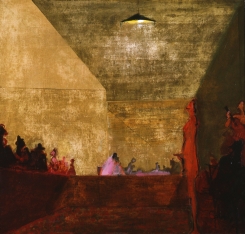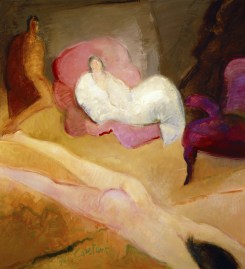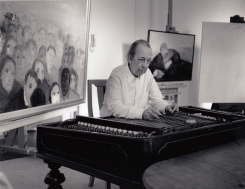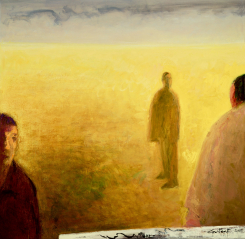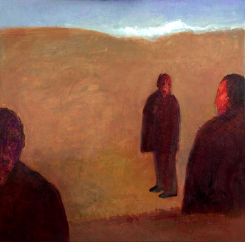Image

After working on New Babylon for about fiften years Constant Nieuwenhuys returns to painting, watercoloring and graphic work in 1969. After the large New Babylon exhibition in the Gemeentemuseum The Hague (now Kunstmuseum) in 1974 he sells the bulk of the project to the museum, cleans out his studio, buys art supplies and starts painting again. Nevertheless, the architectural structures can be seen throughout his work till far in to the seventies. Gradually Constant is inspired by everyday news, like the war in Vietnam, famine in Africa and refugees in Kosovo. His work starts to show a more personal engagement with the world. Marxism remains a big influence in Constant's work. He is being criticized for returning to painting at a time when art trends dictate that painting is passé as an art medium. Rudi Fuchs says the following on the subject in his foreword for the catalogue of Constant's paintings in 1995: Some consider Constant's return to painting a return to tradition. I, however, do not share this opinion. I consider his development from the seventies as a deeper penetration into the garden of painting.
Inspired by the Venetian renaissance painters, especially Titian, Constant applies himself to the technique of colorism. Using this technique the artist doesn't use charcoal or pencil sketches but applies the oil paint straight to the canvas with a brush. He creates soft transitions with color instead of sharp contours. The main feature of this technique is the way in which light is shown in the painting. Light is literally integrated in the color. The painting comes to life layer after layer. Sometimes up to ten layers of paint are used to come to a final result. Constant paints exclusively with oil paint on canvas and every layer has to dry for several days, sometimes a week, before he can continue. It's a laborious process and Constant works on several paintings at the same time, producing only three or four works of art a year.
Till the last month before his death, Constant paints every day in his studio Wittenburg, a gymnasium in an old school on the Oostelijke Eilanden in Amsterdam. Disciplined as he is he plays the cymbalon for at least one and a half hour every day. Having a cymbalon at his house, in his studio and in his wife's home he continues playing it till short before he passes away.
In 1991 he is honoured with the Resistance Award by the Stichting Kunstenaarsverzet 1942-1945 (Art Resistance 1942-1945). He receives the award with the speech Verzet, ook nu! (Resistance, even now!). During the last seven months of his life the documentary, Constant, avant le départ, is filmed. Film makers Maarten Schmidt and Thomas Doebele create a unique and intimate portrait of the painter in his last months. They film Constant on a visit to the depot of the Gemeentemuseum The Hague to see his own work, on a visit to Venice to see one of Constant's biggest inspiration's Titian's Pietà in the Academia, during one last get together with family and friends in Utrecht, during a private concert of musician Nello Mirando and while working on his last painting Le piège* (The ambush). It's distinctive of the trust Constant had in the film makers that he allowed them to be present while he worked, this is unprecendented. The fragments are interlaced with intense conversations in his studio Wittenburg about his life and work.
On August 1st 2005 after an illness lasting several months Constant passes away at his home in Utrecht. At the time he is married to Trudy van der Horst and leaves behind a son, three daughters, a stepdaughter, four grandchildren and two great-grandchildren.
*Le piège is based on an episode in Constant's life that touched him deeply on a personal level. In 2001 Constant is notified that an Academic scholar has included a comment in his dissertation accusing Constant of having registered with Kulturkammer in 1942. The author bases his comment on an archive entry from the NIOD. After further inquiry it turns out that the documentation on which the statement is based has been destroyed. The NIOD is not able identify the person that made the entry, nor who destroyed the 'original document', nor when it was destroyed. In the end the NIOD is unable to come up with any proof to back up the archive entry. The statement seems circumstantial at best. Eventually the comment is skipped from the dissertation but for Constant the damage has been done. He feels betrayed by both the director of the NIOD and the author, whom he considered to be a friend. He creates the painting Le piège (The ambush) as a result. The unsubstantiated archive entry remains in the NIOD's archive to this day.
Early Period 1920-1947
CoBrA 1948-1951
Towards a Synthesis of Art 1952-1956
New Babylon 1956-1974
Situationist International 1958-1960
Late Period 1974-2005

